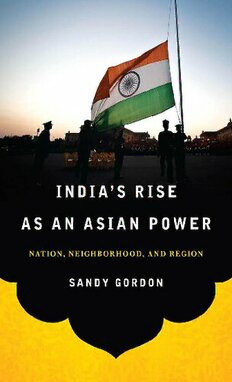
India's Rise as an Asian Power: Nation, Neighborhood, and Region PDF
Preview India's Rise as an Asian Power: Nation, Neighborhood, and Region
India’s Rise as an Asian Power south asia in world affairs series T.V. Paul, Series Editor Editorial Advisory Board Rajesh Basrur Maya Chadda Stephen P. Cohen C. Christine Fair Timothy Hoyt Paul Kapur Rajesh Rajagopalan Aseema Sinha Titles in the Series Afghan Endgames: Strategy and Policy Choices for America’s Longest War Hy Rothstein and John Arquilla, editors The Engagement of India: Strategies and Responses Ian Hall, Editor Globalization and India’s Economic Integration Baldev Raj Nayar India’s Rise as an Asian Power: Nation, Neighborhood, and Region Sandy Gordon Pakistan’s Counterterrorism Challenge Moeed Yusuf, Editor Vying for Allah’s Vote: Understanding Islamic Parties, Political Violence, and Extremism in Pakistan Haroon K. Ullah India’s Rise as an Asian Power: Nation, Neighborhood, and Region sandy gordon Georgetown University Press / Washington, DC © 2014 Georgetown University Press. All rights reserved. No part of this book may be reproduced or utilized in any form or by any means, electronic or mechanical, including photocopying and recording, or by any information-storage-and-retrieval system, without permission in writing from the publisher. Library of Congress Cataloging-in-Publication Data Gordon, A. D. D. India’s rise as an Asian power : nation, neighborhood, and region / Sandy Gordon. pages cm. -- (South Asia in world affairs series) Includes bibliographical references and index. ISBN 978-1-62616-110-8 (hardcover : alk. paper) -- ISBN 978-1-62616-074-3 (pbk. : alk. paper) 1. India--Politics and government--21st century. 2. India--Economic conditions- -21st century. 3. National security--India. 4. India--Foreign relations. 5. India- -Foreign economic relations. 6. India--Foreign relations--South Asia. 7. South Asia--Foreign relations--India. I. Title. DS449.G67 2014 327.54--dc23 2014000936 This book is printed on acid-free paper meeting the requirements of the American National Standard for Permanence in Paper for Printed Library Materials. 15 14 9 8 7 6 5 4 3 2 First printing Printed in the United States of America MANAN VATSYAYANA / AFP / Getty Images To Flora, Solomon, Robin, Dashiell, and others who may come along This page intentionally left blank Contents (cid:2) Preface ix Author’s Note on Currency Conversion xi Abbreviations xiii Introduction xvii chapter 1 Governance and the “Hybrid Inheritance” 1 chapter 2 Enmeshed Dissonance in South Asia 43 chapter 3 South Asian Dissonance, Global Factors, and Global Power Competition 79 chapter 4 Wider Regional Implications 111 chapter 5 The Government Response: Domestic Governance and Security 155 chapter 6 External Strategies and Challenges: From Neighborhood to Region 181 Conclusion 207 Bibliography 213 About the Author 245 Index 247 vii This page intentionally left blank Preface (cid:2) T his book has had a long gestation dating back to the beginning of the 1990s. At that time, I had an Australian government defense fellowship at the Aus- tralian National University (ANU). The outcome was India’s Rise to Power: In the Twentieth Century and Beyond (London: Macmillan, 1995). My thanks are due to Professor Desmond Ball of the ANU for inviting me to undertake that work. In it, I sought to explain what I saw as India’s failure to rise rapidly to power given its megapopulation status. I did so in terms of the constraints India then confronted due to its sprawling domestic polity; difficult South Asian neigh- borhood; emerging environmental issues; flawed policies in education, defense industry, and technological acquisition; and limited progress with economic liber- alization. I described India in this setting as acting according to a “weak-strong” paradigm. I concluded that even though India would likely become a declared nuclear power, its rise as an Asian and global power would be delayed till some- what later in the twenty-first century. Over a decade later I was kindly invited by Professor Peter Grabosky to take up a research position with the Centre of Excellence in Policing and Security (CEPS) at the Regulatory Institutions Network (RegNet), ANU. My thanks are due to Peter and my other colleagues at CEPS and RegNet, including Professor Roderic Broadhurst, who took over from Peter as head of CEPS on his retire- ment. My brief at RegNet was to cover governance, terrorism, and transnational crime. This focus reflected the fact that during the years between my first sojourn at ANU and my second, I had been, among other things, head of intelligence at the Australian Federal Police, equivalent to the Federal Bureau of Investigation in the United States. On returning to ANU, however, I was still keen to revisit my work on India. I decided to do this by again looking at the issue of India’s rise to power, only this time with a greater emphasis on governance issues, especially corruption, terrorism, ix
